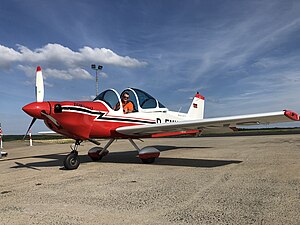| My 102 Tornado | |
|---|---|

| |
| The first prototype | |
| Role | Sporting and aerobatic aircraftType of aircraft |
| National origin | Germany |
| First flight | 7 July 1973 |
| Number built | 2 |
The Mylius My 102 Tornado is a prototype single-seat German aerobatic aircraft. It was designed as a smaller derivative of the MBB Bo 209, but was not placed in production, with only two aircraft built.
Design and development
The German light aircraft manufacturer Bölkow's technical director Dr Hermann Mylius, together with two other engineers from the company, designed the two-seat MHK-101 in their spare time, with the design being adopted by Bölkow as the Bo 209, entering production in 1970. As a follow-on to the Bo-209, Mylius began design work in July 1971 on a smaller, single-seat derivative of the Bo-209, intended as an aerobatic aircraft, the Mylius My 102 Tornado. The My 102 was considered for production by Messerschmitt-Bölkow-Blohm (MBB), the former Bölkow, as the Bo 210 Tornado, but instead, MBB abandoned production of light aircraft in order to concentrate on the Bo 105 helicopter.
The My 102 is a low-wing cantilever monoplane of all-metal construction, powered by a 200 hp (150 kW) Lycoming AIO-360-B1B flat-four piston engine driving a three-bladed propeller. It has a tricycle undercarriage with fixed mainwheels and a nosewheel which was retractable in the prototype with a plan to offer a fixed nosewheel as an option. The pilot sits in an enclosed cockpit, with a rearward sliding canopy. The aircraft's wings can be folded to minimise hangar space needed to store the aircraft or for towing on roads.

Work began on construction of a prototype in December 1971, and it first flew, with the registration D-EMYS, on 7 July 1973 at Neubiberg. It was successful in aerobatic competitions, taking part in the 1973 German Aerobatic Championships and the 1974 Biancotto Trophy. By 1980, a second prototype was under construction, with changes including a more powerful (225 hp (168 kW)) engine, revised wings with reduced span (7.89 m (25 ft 11 in)) and wing area (9.40 m (101.2 sq ft)). Two derivatives of the My 102 were noted as being under development in the 1980 Jane's All the World's Aircraft, the two-seat My 103 Mistral (eventually to fly in 1998) and the four-seat My 104 Passat.
The second prototype, registration D-EMYM, flew for the first time on 3 April 1984. The Tornado (now styled MY-102) was being proposed for production by Mylius Flugzeugwerk of Bitburg in 1999, and was claimed to conform to European Joint Aviation Authorities airworthiness standards. Mylius was concentrating on the MY-103 by 2003, however.
Specifications (First prototype)

Data from Jane's All the World's Aircraft 1975–76
General characteristics
- Crew: 1
- Length: 6.40 m (21 ft 0 in)
- Wingspan: 8.10 m (26 ft 7 in)
- Height: 2.31 m (7 ft 7 in)
- Wing area: 9.80 m (105.5 sq ft)
- Aspect ratio: 6.7:1
- Airfoil: NACA 64215 at root, NACA 64212 at tip
- Empty weight: 530 kg (1,168 lb)
- Max takeoff weight: 820 kg (1,808 lb)
- Fuel capacity: 146.8 L (38.8 US gal; 32.3 imp gal)
- Powerplant: 1 × Lycoming AIO-360-B1B air-cooled flat-four engine, 150 kW (200 hp)
- Propellers: 3-bladed Hoffmann HO-V 123/180R metal constant-speed propeller, 1.80 m (5 ft 11 in) diameter
Performance
- Maximum speed: 322 km/h (200 mph, 174 kn)
- Cruise speed: 296 km/h (184 mph, 160 kn)
- Stall speed: 97 km/h (60 mph, 52 kn) (flaps down)
- Never exceed speed: 396 km/h (246 mph, 214 kn)
- Range: 960 km (600 mi, 520 nmi)
- Service ceiling: 9,100 m (30,000 ft)
- Rate of climb: 12 m/s (2,400 ft/min)
References
- The 1971 edition of Jane's All the World's Aircraft described the proposed Bo 210 as a two seat aircraft with fully retractable landing gear, and also mentioned a four-seat Bo 211 Taifun based on the Bo 210.
- Archive 1991 No. 2, p. 46.
- Taylor 1968, pp. 80–81.
- ^ Archive 1991 No. 3, p. 76.
- ^ Taylor 1975, p. 94.
- Taylor 1971, p. 88.
- Taylor 1971, p. 89.
- Archive 1991 No. 3, pp. 75–76.
- ^ Taylor 1975, pp. 94–95.
- ^ Taylor 1980, p. 84.
- Taylor 1980, pp. 84–85.
- Taylor 1999, p. 429.
- ^ Jackson 2003, p. 171.
- Taylor 1999, pp. 429–430.
- "Aircraft of European Civil Registers : 6: The Bölkow Lightplanes: Part Six". Archive. No. 2. Air-Britain. 1991. pp. 45–48. ISSN 0262-4923.
- "Aircraft of European Civil Registers : 6: The Bölkow Lightplanes: Part Seven". Archive. No. 3. Air-Britain. 1991. pp. 73–76. ISSN 0262-4923.
- Jackson, Paul, ed. (2003). Jane's All the World's Aircraft 2003–2004. Coulsdon, UK: Jane's Information Group. ISBN 0-7106-2537-5.
- Taylor, John W. R., ed. (1968). Jane's All The World's Aircraft 1968-69. London: Sampson Low, Marston & Company, Ltd.
- Taylor, John W. R., ed. (1971). Jane's All The World's Aircraft 1971-72. London: Jane's Yearbooks. ISBN 0-354-00094-2.
- Taylor, John W. R., ed. (1975). Jane's All the World's Aircraft 1975–76. London: Jane's Yearbooks. ISBN 0-354-00521-9.
- Taylor, John W. R., ed. (1980). Jane's All the World's Aircraft 1980–81. London: Jane's Publishing Company. ISBN 0-7106-0705-9.
- Taylor, Michael J. H., ed. (1999). Brassey's World Aircraft & Systems Directory: 1999/2000. London: Brassey's. ISBN 1-85753-245-7.